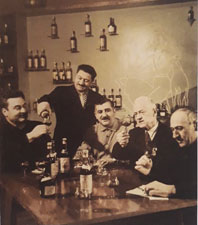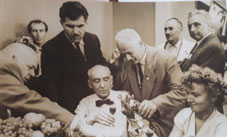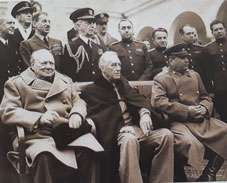
Vakhtang Tsitsishvili - Country of Liquid Sun
Thursday, May 21
Vakhtang Tsitsishvili, after graduation from the Dijon (France) Higher Agricultural School, worked in the position of Assistant Specialist at the Sarajishvill Cognac Factory from 1915. Between 1924-1949, he was the Chief Specialist and then Technical Director of the Cognac Factory. In 1949, he was invited to be the Chief technologist at the newly established Cognac Complex. From 1953, he continued his activities at the "Samtrest" cognac enterprise where he worked as its Chief Technologist until the end of his life.
Vakhtang Tsitsishvili introduced a number of innovations into Georgian cognac-making technology. Primarily, he introduced the aging of cognac spirits by means of a step-by-step filling method which provides for the filling of old cognac spirits by relatively young spirits which is very important in that it allowed for the creation of a large stock of high quality spirits.
Tsitsishvili created well-known Georgian brand cognacs, like Eniseli, Gremi, Saiubileo-20. Tbilisi, Saiubileo-40 and Vartsikhe, amongst others, based upon local raw material. Since 1930 and under his direct leadership, the assortment of Georgian liqueurs has also been extended which, together with Benedictine and Chartres, include new Georgian brand liqueurs such as Vardi, Kolkhida, "sitrusis Kvavili, Samxretis Kvavili, Mocco and Shokoladi, amongst others, which have met with great approval.
Tsitsishvili was the first one who applied marketing approaches and finally achieved the bottling of Georgian liqueur, vodka and cognac in different bottles with improved cork quality and a focus upon the external appearance of the product. It was ion the 1830s that the first brand bottles for cognac, Dzalian Dzveli, and the liqueurs, Benedictine and Vardi, appeared.
One story, involving Winston Churchill and Georgian cognac, still goes around as a legend to this day. In the neighbouring country of Armenia, officially or unofficially and in the press or publicly, the fact that Churchill, allegedly, used to drink the Armenian cognac. Dvin, is subject to a number of different interpretations, even today. In fact, what happened in reality was this: In 1945, at the Yalta Conference, the leaders of the Great Three -America, England and the Soviet Union- were served drinks after the completion of the event's official part. Churchill was offered cognac. He tried it, did not like it and set it aside. According to Stalin's order, the rejected drink was replaced by Georgian cognac. Churchill tasted it and said: "But this one is excellent, is it French?" Stalin noted: "It's not French, but Georgian." "But it might be made by French specialists at least," Churchill tried to insist upon his opinion. It was later explained to him that no foreigners were working in the Georgian cognac industry.
The cognac Eniseli is called the pride of Georgian cognacs. "Eniseli is the water of immortality." That is how the representatives of the Italian commercial firm, Anjelo Guala, have referred to the Georgian brand cognac. Furthermore, the President of the firm, Pierrot Dzavataro, applied to the administration of "Samtrest" Georgian in 1978 with the request for a regular supply of Georgian cognac provided that the words "Aqua Vitae" that is, the water of life, would be added to the label.





